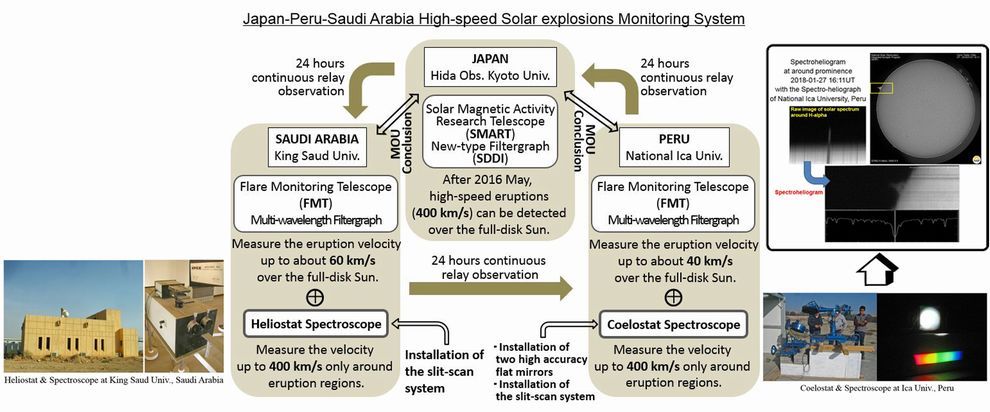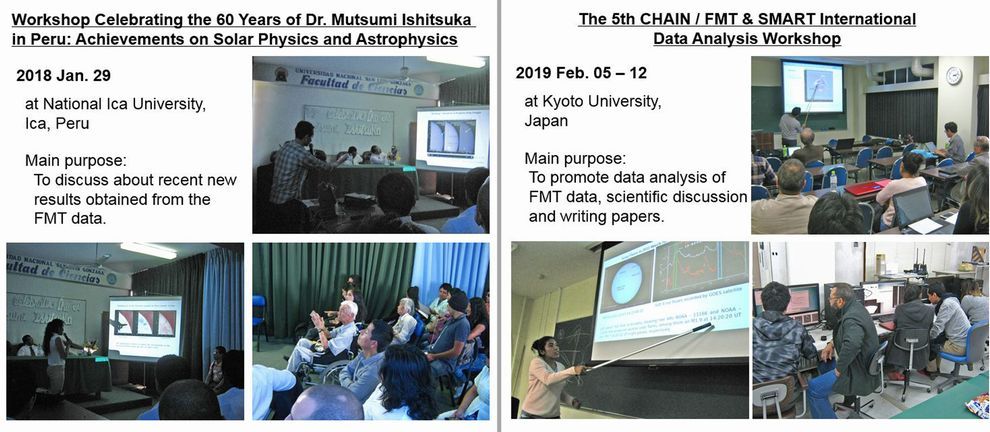Construction and utilization of Japan-Peru-Saudi Arabia high-speed solar explosion monitoring system
Project Gist
International cooperative researches of solar explosive phenomena by improving international solar observation network
Keywords
Solar Physics, Upper Atmosphere Physics, Space Weather Research, Prominence
Background and Purpose
Our observatory has promoted an international solar observation network project (CHAIN project) in which we use very characteristic solar telescopes that can measure 3 dimensional velocity field of erupted solar plasma, in order to monitor solar explosive phenomena for 24 hours continuously and investigate influences of such phenomena on the space and earth’s upper atmosphere. In this SPIRITS, we aim to promote such international collaborative researches by adding new instruments, that can measure further faster explosive phenomena, to each solar station in Japan, Peru and Saudi Arabia.
Project Achievements
As shown in figure 1, we planned to improve existing solar spectroscopes in Peru and Saudi Arabia, so that further faster phenomena can be observed with spectroscopic method.
Regarding the Peruvian station, the improvement was completed safely, and we performed training of the observation and data analysis to Peruvian students and young researchers.
On the other hand, as for the Saudi Arabian station, we couldn’t achieve using the spectroscope because of a trouble in existing facility owned by the host university. Therefore, we continued solar observation only with a Flare Monitoring Telescope.
During these two years, we held a symposium and a data analysis workshop in Peru and Japan (figure 2) and promoted international collaborative researches. As the result, we got new foreign students as coresearchers. Moreover, we had meeting about the academic exchange cooperation agreement in each university in Peru and Saudi Arabia, and we agreed to conclude the agreement in near future, respectively.
Future Prospects
After this also, we want to try to get budget for this project, and complete concluding cooperative agreements between Kyoto University and Ica University, King Saud University, so that we continue to promote international cooperative researches and try to achieve utilizing the spectroscope in Saudi Arabia, and support new Peruvian students who hope to enter the graduate school of Kyoto University.
Figure


Joint Research/Academic Institutions Abroad
Universidad Nacional San Luis Gonzaga de Ica, Universidad Nacional del Centro del Perú, Instituto Geofísico del Perú, King Saud University
Principal Investigator

・UENO Satoru
・Graduate School of Science
・Assistant Professor of Hida Observatory. He has been in charge of the practical business of the CHAIN project that was started in 2006 by Hida Observatory. He performed installation of the Flare Monitoring Telescope (FMT) in Peru, and supported building of another FMT in Saudi Arabia.
http://researchmap.jp/read0193111
http://www.kwasan.kyoto-u.ac.jp/~ueno/
http://twitter.com/ueno_at_hidaobs
